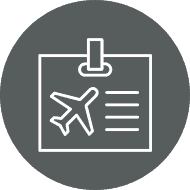Colgan Air Services’ Private Pilot Ground School is designed to assist students in preparing for the FAA Private Pilot Written Exam. Throughout your training, you will learn the concepts of airplane systems, flight planning, weather and aerodynamics in a classroom setting. The course meets twice a week during the evenings for an 8-week period, and is held approximately once every season.
Colgan Air incorporates the Jeppessen Private Pilot manuals in conjunction with FAA issued reference books. Our fee for the course is $300 plus materials, which can be purchased at Colgan Air.
Interested in signing up? You can stop into Colgan Air or call our Customer Service Representative. Class registration and purchase of class supplies is done in person at Colgan Air and must be completed one week prior to the first class. We look forward to having you in our class!
Frequently Asked Questions

What are a few of the topics that are taught in Ground School?
Topics include but are not limited to: principle of lift, gravity, drag control, airspeed and basic instrumentation of the aircraft.

Is taking Ground School a requirement for a private pilot’s license?
No, it is not. It is designed to assist the student in preparing for the FAA Private Pilot written exam. Furthermore, there are significant benefits to attending the class. It will increase your knowledge of safe air travel, and you will be learning from highly experienced instructors who will help you prepare for your exam.
Do you offer Ground School for your Instrument Rating?
Yes, but they are not as frequent. To receive further details, call our Customer Service Representative.

What equipment or books are used in class?
Colgan Air Services uses the Jeppesen Private Pilot kit, which includes: a Private Pilot Textbook, Maneuvers Manual, Practical Test Standards, Practical Test Study Guide, FAA Airmen Knowledge Test Guide, Pre-solo Written Exam, FAR/AIM Manual, E6B, PN-1 Navigation Plotter and logbook.

How is the class conducted?
The class is taught through a series of lectures and discussions with the instructor encouraging class participation. The instructor frequently uses videos, powerpoint presentations and guest speakers. The instructor uses an aircraft to demonstrate where aircraft components and parts are located. Overall, the class is taught through different methods that has proven to help the students retain the material.
